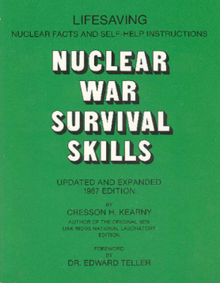
A fallout shelter is an enclosed space specially designated to protect occupants from radioactive debris or fallout resulting from a nuclear explosion. Many such shelters were constructed as civil defense measures during the Cold War.

Nuclear warfare, also known as atomic warfare, is a military conflict or prepared political strategy that deploys nuclear weaponry. Nuclear weapons are weapons of mass destruction; in contrast to conventional warfare, nuclear warfare can produce destruction in a much shorter time and can have a long-lasting radiological result. A major nuclear exchange would likely have long-term effects, primarily from the fallout released, and could also lead to secondary effects, such as "nuclear winter", nuclear famine, and societal collapse. A global thermonuclear war with Cold War-era stockpiles, or even with the current smaller stockpiles, may lead to various scenarios including the extinction of the human species.

Nuclear fallout is the residual radioactive material propelled into the upper atmosphere following a nuclear blast, so called because it "falls out" of the sky after the explosion and the shock wave has passed. It commonly refers to the radioactive dust and ash created when a nuclear weapon explodes. The amount and spread of fallout is a product of the size of the weapon and the altitude at which it is detonated. Fallout may get entrained with the products of a pyrocumulus cloud and fall as black rain. This radioactive dust, usually consisting of fission products mixed with bystanding atoms that are neutron-activated by exposure, is a form of radioactive contamination.
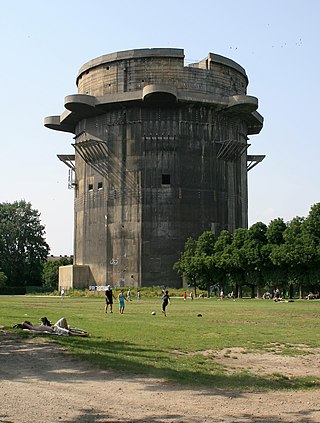
A bunker is a defensive military fortification designed to protect people and valued materials from falling bombs, artillery, or other attacks. Bunkers are almost always underground, in contrast to blockhouses which are mostly above ground. They were used extensively in World War I, World War II, and the Cold War for weapons facilities, command and control centers, and storage facilities. Bunkers can also be used as protection from tornadoes.
A cobalt bomb is a type of "salted bomb": a nuclear weapon designed to produce enhanced amounts of radioactive fallout, intended to contaminate a large area with radioactive material, potentially for the purpose of radiological warfare, mutual assured destruction or as doomsday devices.

Acute radiation syndrome (ARS), also known as radiation sickness or radiation poisoning, is a collection of health effects that are caused by being exposed to high amounts of ionizing radiation in a short period of time. Symptoms can start within an hour of exposure, and can last for several months. Early symptoms are usually nausea, vomiting and loss of appetite. In the following hours or weeks, initial symptoms may appear to improve, before the development of additional symptoms, after which either recovery or death follow.
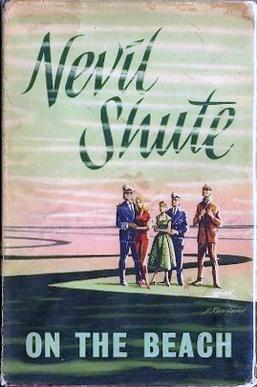
On the Beach is an apocalyptic novel published in 1957, written by British author Nevil Shute after he emigrated to Australia. The novel details the experiences of a mixed group of people in Melbourne as they await the arrival of deadly radiation spreading towards them from the Northern Hemisphere, following a nuclear war some years previous. As the radiation approaches, each person deals with impending death differently.

Protect and Survive was a public information campaign on civil defence. Produced by the British government between 1974 and 1980, it intended to advise the public on how to protect themselves during a nuclear attack. The campaign comprised a pamphlet, newspaper advertisements, radio broadcasts, and public information films. The series had originally been intended for distribution only in the event of dire national emergency, but provoked such intense public interest that the pamphlet was published, in slightly amended form, in 1980. Due to its controversial subject, and the nature of its publication, the cultural impact of Protect and Survive was greater and longer-lasting than most public information campaigns.

"Duck and cover" is a method of personal protection against the effects of a nuclear explosion. Ducking and covering is useful in offering a degree of protection to personnel located outside the radius of the nuclear fireball but still within sufficient range of the nuclear explosion that standing upright and uncovered is likely to cause serious injury or death. In the most literal interpretation, the focus of the maneuver is primarily on protective actions one can take during the first few crucial seconds-to-minutes after the event, while the film of the same name and a full encompassing of the advice also cater to providing protection up to weeks after the event.

Duck and Cover is a 1952 American civil defense animated live-action social guidance film that is often popularly mischaracterized as propaganda.

A blast shelter is a place where people can go to protect themselves from blasts and explosions, like those from bombs, or in hazardous worksites, such as on oil and gas refineries or petrochemical facilities. It differs from a fallout shelter, in that its main purpose is to protect from shock waves and overpressure instead of from radioactive precipitation, as a fallout shelter does. It is also possible for a shelter to protect from both blasts and fallout.
Geiger counter is a colloquial name for any hand-held radiation measuring device in civil defense, but most civil defense devices were ion-chamber radiological survey meters capable of measuring only high levels of radiation that would be present after a major nuclear event.

United States civil defense refers to the use of civil defense in the history of the United States, which is the organized non-military effort to prepare Americans for military attack and similarly disastrous events. Late in the 20th century, the term and practice of civil defense fell into disuse. Emergency management and homeland security replaced them.
Bruce D. Clayton is a noted forest fire and biological control ecologist as well as being the author of several books of interest within the survivalist movement.
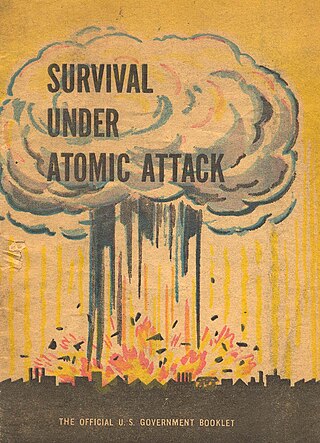
Survival Under Atomic Attack was the title of an official United States government booklet released by the Executive Office of the President, the National Security Resources Board, and the Civil Defense Office. Released at the onset of the Cold War era, the pamphlet was in line with rising fears that the Soviet Union would launch a nuclear attack against the United States, and outlined what to do in the event of an atomic attack.
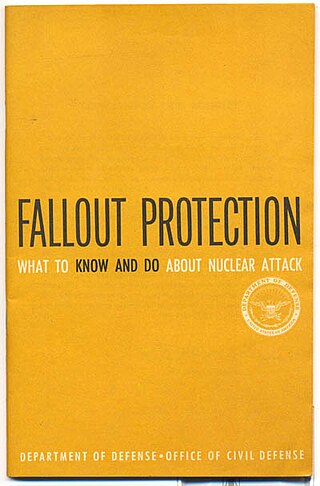
Fallout Protection: What To Know And Do About Nuclear Attack was an official United States federal government booklet released in December 1961 by the United States Department of Defense and the Office of Civil Defense. The first page of the book is a note from then-U.S. Secretary of Defense Robert McNamara explaining that the booklet is a 48 page book made for the result of the first task he was given when he assumed responsibility for the Federal Civil Defense Program in August 1961. The task, assigned by President John F. Kennedy, was to "give the American people the facts they need to know about the dangers of a thermonuclear attack and what they can do to protect themselves."
Cresson Henry Kearny wrote several survival-related books based primarily on research performed at Oak Ridge National Laboratory.
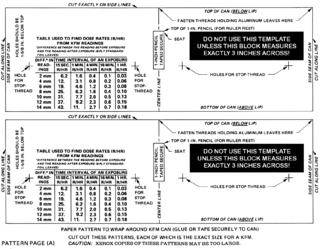
The Kearny fallout meter, or KFM, is an expedient radiation meter. It is designed such that someone with a normal mechanical ability would be able to construct it before or during a nuclear attack, using common household items.
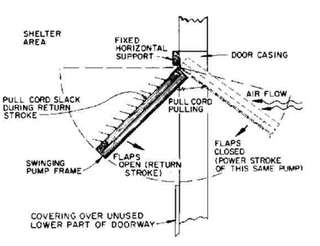
The Kearny air pump is an expedient air pump used to ventilate a shelter. The design is such that a person with normal mechanical skills can construct and operate one. It is usually human-powered and designed to be employed during a time of crisis. It was designed to be used in a fallout shelter, but can be used in any situation where emergency ventilation is needed, as after a hurricane.
In the survivalist subculture or movement, a retreat is a place of refuge. Sometimes their retreats are called a bug-out location (BOL), a bunker, a bolt hole or a hidesite. Survivalist retreats are intended to be self-sufficient and easily defended. Generally, they are located in sparsely populated outback rural areas.
